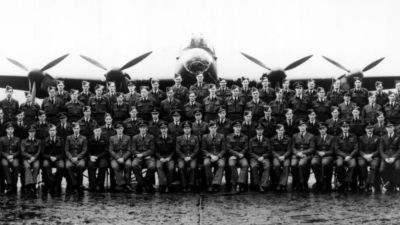In pictures: The WWII Dambusters operation

It is the 70th anniversary of one of the most famous air operations of World War II, the Dambusters raid.
Codenamed Operation Chastise, the audacious mission was part of the Allies bombing campaign against Germany.
It was carried out by the RAF 617 squadron, an elite Lancaster bomber unit, led by 24-year-old Wing Commander Guy Gibson.
The British airmen were joined by Canadian, Australian and New Zealand allies plus one American.
The targets were three water dams in Germany's Ruhr industrial region. Two on the rivers Möhne and Sorpe, and a third on the River Eder.
The operation took place under the cover of darkness from 16-17 May 1943, with bombs specifically invented for the task by aircraft engineer Dr Barnes Wallis.
The "bouncing bombs" - codenamed "Upkeep" - were designed to be dropped from a very low altitude, and bounce on the water to bypass the defences around the dams.
The 617 squadron were trained to fly at less than 100ft above the water, the height required to drop the bombs successfully.
Three waves of aircraft were sent to attack:
First Wave: Nine aircraft in 3 “vics” of 3, to attack the Mohne, Eder and Sorpe dams.
Second Wave: Five aircraft, to attack the Sorpe
Third Wave: Five aircraft, airborne reserve
The first dam to be attacked was the Mohne.
Next to be targeted was the Eder Dam.
RAF cameras captured the aftermath of the bombs as tons of water in the Eder reservoir began to pour through the breach.
Although the raid was fairly successful, the squadron failed to breach the Sorpe dam. However, flooding from the other two dams caused disruption in a large number of towns.
A survivor of the 617 Squadron, bomb-aimer Sergeant George "Johnny" Johnson, spoke to ITV News' Paul Davies about his memories of the operation.
He said there was sense of achievement of damaging the Sorpe although it was not breached.
Mr Johnson also described how as the squadron set course for home and flew over the Mohne Dam, "It was just like an inland sea. There was water everywhere.
"The defences by this time were non-existent.....we had at least the satisfaction of seeing the damage that had been done, for that we were quite grateful".
The human cost of the Operation Chastise also proved to be high.
Eight of the original 19 Lancaster bombers were damaged or shot down, and 53 of the 133 aircrew were killed. Three others were captured.
There were also nearly 1300 losses on the ground.
Despite this, the action boosted British morale and the aircrew were hailed war heroes.
The 617 Squadron's story was also brought to the big screen in the 1955 film The Dam Busters starring Michael Redgrave.